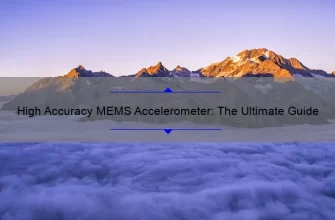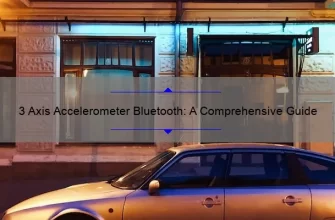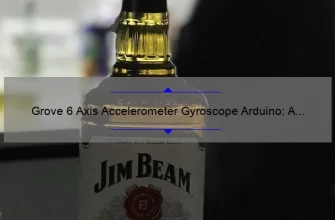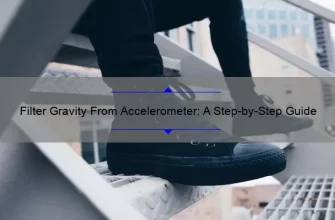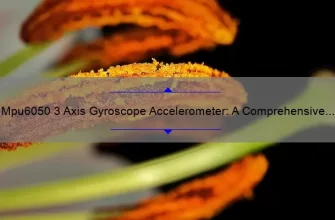- Short answer: Drone with gyroscope
- How Does a Drone with Gyroscope Technology Work?
- Step-by-Step Guide: Building Your Own Drone with Gyroscope
- Exploring the Benefits of Using a Drone with Gyroscope
- Frequently Asked Questions about Drones with Gyroscope
- Tips and Tricks for Flying a Drone with Gyroscope Technology
- Enhancing Photography and Videography with a Drone Equipped with Gyroscope
Short answer: Drone with gyroscope
A drone with a gyroscope refers to an unmanned aerial vehicle (UAV) equipped with a gyroscope sensor. This sensor helps in maintaining stability, enhancing flight control, and assisting in autopilot capabilities. The gyroscope provides orientation information and aids in stabilizing the drone’s movements, resulting in smoother flight and improved aerial photography or videography capabilities.
How Does a Drone with Gyroscope Technology Work?
How Does a Drone with Gyroscope Technology Work?
In the ever-advancing world of technological marvels, drones have undoubtedly taken center stage. These unmanned aerial vehicles (UAVs) not only provide stunning aerial views but also have a wide array of applications, from cinematography and surveillance to search and rescue operations. Behind the scenes, one of the key factors contributing to their stability and maneuverability is gyroscope technology.
Imagine an invisible force guiding the drone’s every move, keeping it steady in even the most turbulent conditions – that’s where the gyroscope comes in. At its core, a gyroscope is a device that detects changes in orientation and helps maintain stability by counteracting unanticipated movements.
So how does a drone with gyroscope technology work? Let’s dive into the details:
1. Sensing Orientation: A gyroscopic sensor located within the drone continuously monitors its orientation in space using three axes – pitch, roll, and yaw. The pitch axis represents forward or backward tilt, while roll refers to lateral movement from side to side. Lastly, yaw denotes rotation around an imaginary vertical axis.
2. Detecting Changes: As the drone moves or experiences external forces acting upon it (such as wind gusts), the gyroscope senses these changes instantaneously due to its high precision sensors. This information is relayed to the flight controller or autopilot system.
3. Compensating for Movement: Upon receiving data about any shifts in orientation, the onboard flight controller employs algorithms designed specifically for stabilization purposes. By swiftly processing information from various sensors including accelerometers and magnetometers alongside gyroscope data, it determines which motors need adjustments.
4.Sending Corrective Signals: The flight controller then sends commands to specific motors via electronic speed controllers (ESCs). The ESCs moderate motor speed or torque promptly based on instructions received, allowing necessary corrections to be made accordingly.
5.Maintaining Stability: With these immediate motor adjustments, the drone counteracts any unwanted movements in real-time. Whether it’s wind gusts pushing the UAV off course or quick turns during agile flight, the gyroscope ensures that stability is maintained, and precise flight paths are achieved.
Gyroscopes used in drones usually adopt microelectromechanical systems (MEMS) technology. These highly compact sensors can sense even minuscule changes, allowing for stable flight in various conditions. In addition to this, advanced drone models often integrate multiple gyroscopes together with other sensors to enhance overall performance further.
While a gyroscope plays a vital role in ensuring stability during drone operation, it should be noted that controlling and directing a UAV involves a combination of many other factors such as GPS systems, accelerometers, barometers, and magnetometers. Nonetheless, the gyroscopic technology provides a crucial foundation for maintaining equilibrium and precision in flight.
Next time you marvel at an awe-inspiring aerial display or see drones performing intricate maneuvers effortlessly – remember the unsung hero working diligently within its framework: the humble gyroscope. This ingenious device continues to revolutionize not only the world of drones but also numerous other industries with its remarkable ability to maintain balance amidst chaos.
Step-by-Step Guide: Building Your Own Drone with Gyroscope
Title: A Comprehensive Step-by-Step Guide: Unleashing Your Inner Engineer with Gyroscopes for Drone Building
Introduction:
Welcome to our ultimate guide on building your very own drone equipped with a gyroscope! This advanced technology is integral for stable and controlled flight, making it an essential component for any serious drone enthusiast. Don’t worry if you think this sounds complex – we’ll break it down into simple steps, packed with professional advice and a dash of wit to make your journey as enjoyable as possible!
Step 1: Understanding the Basics of Gyroscopes
Let’s begin by demystifying the magnificent world of gyroscopes. These nifty devices work on the principles of angular momentum and help guide drones in maintaining balance during flight. Dive into the intriguing science behind gyroscopes, grasping their role in stabilizing drones, and why incorporating one into your DIY project can take your flying experience to new heights.
Step 2: Researching Ideal Drone Models & Components
Next up is thorough research on various drone models and corresponding compatible components. Delve into the drone market, scrutinizing different frames, motors, propellers, batteries, and controllers available. Our witty tips will help you identify trustworthy manufacturers while keeping an eye out for unique features that complement your desired flight capabilities.
Step 3: Assembling the Chassis & Frame
Now it’s time to get hands-on! Follow our detailed instructions for assembling the chassis and frame of your soon-to-be airborne companion. From organizing all components meticulously to ensuring solid connections using reliable fasteners – these construction steps ensure stability, durability, and aesthetics.
Step 4: Integrating Motors & Propellers
A true Jedi master knows how important power distribution is! We’ll guide you through attaching motors to the frame while skillfully mounting propellers – maximizing thrust efficiency without compromising alignment or causing unwanted vibrations (which no one wants from their drone!).
Step 5: Wiring and Electronic Connections
Electronics can make or break your drone, so meticulous wiring is key. We’ll walk you through carefully connecting each component – flight controller, battery, ESC (Electronic Speed Controller), and receiver – while ensuring efficient power distribution without any unsightly spaghetti-like tangles.
Step 6: Adding Gyroscopic Stability
Here’s where the magic happens: integrating a gyroscope for impeccable stability in flight. We’ll provide an insightful step-by-step process to connect your chosen gyroscope module with the flight controller, enabling real-time adjustments to ensure level-headed airborne adventures.
Step 7: Fine-tuning Flight Controls & Testing
Assemble your drone army! With all components aligned and configured correctly, it’s time to strap on those goggles and conduct some test flights. We’ll guide you to calibrate control settings with precision, tweak various parameters if necessary, and even share some witty anecdotes from our test pilots’ experiences!
Conclusion:
Congratulations, dear reader! You’ve embarked on an incredible journey of building your very own drone armed with gyroscopic stability – a remarkable feat that only a select few dare venture upon. From understanding the principles of gyroscopes to meticulously assembling intricate components, you have successfully brought a piece of engineering marvel into existence.
Remember that the true joy lies not just in achieving flight but in constantly learning and improving. So embrace this newfound mastery over drones and never stop exploring the limitless possibilities that await above the clouds!
Happy flying!
Exploring the Benefits of Using a Drone with Gyroscope
In today’s ever-evolving technological landscape, drones have become an increasingly popular tool for various industries and recreational activities. These unmanned aerial vehicles (UAVs) are not only capable of capturing stunning aerial imagery but also come equipped with advanced features that enhance their flight stability and maneuverability. One such feature is a gyroscope, which plays a crucial role in ensuring precise control and steady flight paths. In this blog post, we will dive deep into the benefits of using a drone with gyroscope technology, unveiling the clever advantages that come along with it.
Before delving into the advantages, let’s first understand what a gyroscope is and how it functions in drones. A gyroscope is essentially a device that measures angular velocity or orientation changes in an aircraft. It comprises a spinning wheel or rotor that tries to maintain its position in space, resisting any external forces acting upon it. By integrating this mechanism into drones, manufacturers empower these aerial marvels to stay balanced and counteract any unwanted rotations during flight.
One of the primary benefits of utilizing a drone with a gyroscope system lies in its ability to offer unparalleled stability during flights. Drones equipped with gyroscopes can remain level even when faced with external disturbances like wind gusts. This means you can capture incredibly smooth video footage or take high-resolution images without worrying about shaky results. Whether you’re shooting for professional cinematography purposes or simply enjoying recreational photography, having stable imagery elevates your final output to new heights.
In addition to stability, another advantage of using a drone with gyroscopic capabilities is enhanced flight control precision. Thanks to the sensitive measurement readings provided by gyroscopes, drones can respond swiftly and accurately to pilot commands. This aspect becomes particularly valuable when maneuvering through challenging terrains or tight spaces where quick reflexes are paramount for avoiding obstacles. With precise control at your fingertips, you can navigate confidently through narrow tree gaps or architectural wonders while capturing every breathtaking detail from above.
Furthermore, when it comes to aerial photography and videography, a drone’s ability to maintain steady flight paths becomes an absolute game-changer. The integration of gyroscope technology ensures that your shots are not only stable but also follow a predetermined trajectory flawlessly. This opens up a world of creative possibilities – you can now plan intricate aerial sequences or execute complex camera movements with unparalleled accuracy. From sweeping panoramas to smoothly flying alongside moving subjects, the possibilities are limited only by your imagination.
Apart from its direct impact on flight stability and control, using a drone with gyroscope further enhances safety during flights. By providing real-time feedback on rotations and movements, gyroscopes aid in preventing uncontrolled spinning or drifting that could potentially lead to accidents or crashes. These sensors constantly keep the drone’s system updated, allowing for swift adjustments and maintaining overall flight integrity. Augmenting safety measures is always crucial when handling these powerful aerial machines, ensuring not only the protection of the equipment itself but also the surrounding environment and people.
In conclusion, drones equipped with gyroscopic technology are revolutionizing the way we capture stunning visuals from above. Their ability to offer stability, precise control, flawless flight paths, and heightened safety is truly remarkable. Whether you’re an aspiring filmmaker looking to add breathtaking aerial shots to your next project or simply an enthusiast wanting to take your photography skills sky-high, investing in a drone with a gyroscope system will undoubtedly elevate your experience like never before.
So why settle for shaky footage or unpredictable flights? Embrace the benefits of using a drone with gyroscope technology and unlock endless possibilities in capturing awe-inspiring moments from previously unimaginable heights!
Frequently Asked Questions about Drones with Gyroscope
Frequently Asked Questions about Drones with Gyroscope
Drones have become increasingly popular over the years, and one feature that is commonly found in many models is a gyroscope. However, there are still plenty of questions surrounding this technology and its role in drone flight. In this blog post, we will answer some of the frequently asked questions about drones with gyroscopes – from what they are to how they can enhance your flying experience.
1. What is a gyroscope?
A gyroscope is a sensor that helps stabilize and control the orientation of a drone during flight. It works by measuring angular velocity or rotation around different axes, allowing the drone to maintain its balance while maneuvering in the air.
2. Why do drones need a gyroscope?
Gyroscopes play a crucial role in ensuring stability and precision during flight. They help drones maintain their desired altitude, position, and attitude (i.e., orientation). Without a gyroscope, drones would struggle to stay level and would be prone to drifting off course or losing control.
3. How does a gyroscope work?
In simple terms, a gyroscope consists of small vibrating accelerometers or tiny rotating wheels that detect rotation movements. These sensors measure changes in velocity along different axes: pitch (tilting up and down), roll (tilting side-to-side), and yaw (rotating left or right). By constantly monitoring these movements, the gyroscope sends feedback signals to an on-board flight controller, helping it make instantaneous adjustments for stable flight.
4. Can I fly a drone without a gyroscope?
Most modern consumer-grade drones come equipped with at least one gyroscopic sensor as part of their stabilization systems. While it’s technically possible to fly without one, having a gyro greatly enhances your flying experience by providing smoother flights and more precise controls – especially when performing complex maneuvers or flying in challenging conditions such as strong winds.
5. What benefits does the gyroscope offer for aerial photography?
For photographers and videographers, a gyroscope-equipped drone is a game-changer. The gyroscope stabilization system reduces unwanted vibrations caused by drone movements, resulting in steady and professional-quality footage. This feature allows you to capture stunning aerial shots without the need for costly external gimbals or post-production stabilizations.
6. Can I fly a drone with a gyroscope indoors?
Absolutely! The gyroscope technology used in drones enables stable flight not only outdoors but also when flying indoors. However, it’s always important to ensure proper safety precautions, such as selecting an appropriate flight mode and keeping a safe distance from obstacles.
7. Are there any limitations to drones with gyroscopes?
While gyroscopes vastly improve stability during flight, they do have some limitations. They rely on an uninterrupted power supply and can be affected by magnetic interference or extreme temperatures. It’s essential to understand these limitations and take preventive measures to optimize your drone’s performance.
In summary, a gyroscope revolutionizes the flying experience of any drone pilot by providing crucial stability and control features. With its ability to monitor rotation along different axes, it ensures smooth flights, precise maneuverability, and exceptional aerial footage for both hobbyists and professionals alike. So whether you’re capturing breathtaking landscapes or seeking an adrenaline rush through aerobatics, having a drone equipped with a gyroscope is undeniably an excellent investment!
Tips and Tricks for Flying a Drone with Gyroscope Technology
Title: Mastering Drone Flight with Gyroscope Technology: A Guide to Expert Techniques and Smart Tricks
Introduction:
Drones equipped with gyroscope technology have revolutionized the way we capture breathtaking aerial footage. These gyroscopes, acting as stabilizing sensors, ensure smooth flight, enhanced maneuverability, and stunning visual results. To help you unlock the full potential of your drone’s gyroscope system, we’ve compiled a selection of professional tips and clever tricks. Whether you are a beginner or an experienced pilot looking to elevate your skills, these insights will empower you to take your drone flights to new heights.
1. Understand the Importance of Gyroscopes:
Gyroscopes within drones play a vital role in stability by measuring angular rates and maintaining balance during flight. This technology enables drones to counteract external factors like wind resistance, sudden jerks, or tilts while capturing steady aerial footage. Familiarize yourself with your drone’s specific gyroscope features and functions to optimize its flight performance.
2. Calibrate Your Drone Before Each Flight:
To ensure accurate sensor readings and precise stabilization, it is crucial to calibrate your drone’s gyroscope before taking off. This process involves placing your drone on a level surface and following manufacturer instructions for initiating calibration mode. Proper calibration eliminates any drift from incorrect sensor readings and ensures optimal flight accuracy.
3. Start in Beginner Mode:
As someone new to flying drones with gyroscope technology, it is prudent to activate the beginner mode found in many drones’ settings. This mode reduces sensitivity while providing increased stability during flight, providing an ideal environment for learning the basics of gyroscopic control without risking crashes or unreliable maneuvers.
4. Utilize Attitude Mode:
Once you are comfortable in beginner mode, venture into attitude mode—an intermediate-level choice that offers greater agility while maintaining some stabilization assistance from gyroscopes. Attitude mode allows for more creative movements such as flips or rolls while still benefiting from built-in safety measures, making it an ideal stepping stone towards mastery.
5. Master Manual Mode:
To truly harness the power of gyroscope-enhanced flight, make it a goal to become proficient in manual mode. This advanced setting gives pilots complete control over their drone’s movement, entirely relying on their piloting skills and gyroscopic feedback for stability. Embrace this challenge gradually, honing your abilities while taking gradual steps to handle swift maneuvers and complex aerial shots.
6. Combat Wind Effects:
Flying in windy conditions can pose challenges for even the most experienced pilots. To mitigate these issues, learn how to effectively use your drone’s gyroscope technology to counteract wind influence. By smoothly adjusting pitch and roll angles with minimal jerks while compensating for wind resistance, you can maintain stable flight paths and capture pristine footage even in gusty weather.
7. Take Advantage of Intelligent Flight Modes:
Modern drones often come equipped with intelligent flight modes that leverage gyroscope technology to simplify complex actions. Features like follow-me mode or waypoint navigation utilize gyroscopic stabilization alongside GPS systems to automate specific movements or maintain consistent distances from moving subjects, allowing you to nail those incredible tracking shots effortlessly.
8. Experiment with Gimbal Control:
Gyroscopes are intimately connected with the gimbal systems integrated into high-quality drones—a combination that ensures remarkably stable camera performance during flight. Become familiar with your drone’s gimbal controls and practice adjusting tilt angles mid-flight using either manual commands or automated options affected by gyroscope readings—this elevates your ability to capture smooth cinematic footage.
9. Continuously Monitor Battery Levels:
While focusing on mastering flying techniques utilizing gyroscope technology is essential, overlooking battery levels can lead to unexpected crashes or damage mid-flight. Maintain constant vigilance over remaining battery life as excessive discharge rates might result in unstable or uncontrollable behavior jeopardizing both your drone and collected data.
10. Regularly Update Firmware & Software:
Finally, always ensure your drone’s firmware and accompanying software are up-to-date. Manufacturers regularly release updates that enhance gyroscope performance, optimize stabilization algorithms, and introduce additional intelligent flight modes based on extensive user feedback. Stay connected to the manufacturer’s website or official forums to keep your drone’s capabilities at the cutting edge.
In conclusion, understanding and leveraging gyroscope technology is vital for truly mastering drone flight. These tips and tricks will empower you to maximize your drone’s stability, maneuverability, and visual capabilities while capturing breathtaking aerial footage. By exploring both automated features and challenging manual control techniques, you will unlock endless creative possibilities in the ever-expanding world of drone cinematography. So step into the skies with confidence, armed with gyroscopic wisdom on your quest to capture mesmerizing visuals from new perspectives!
Enhancing Photography and Videography with a Drone Equipped with Gyroscope
Drone technology has revolutionized the fields of photography and videography, allowing professionals and enthusiasts to capture breathtaking aerial shots with ease. Among the many innovations that have taken this technology to new heights, one feature stands out: the gyroscope-equipped drone. In this blog post, we will explore how drones equipped with gyroscopes enhance the quality and creativity of both photography and videography.
Firstly, let’s understand what a gyroscope is in relation to drones. A gyroscope is a device that helps stabilize a drone‘s flight by measuring angular velocity. Essentially, it enables the drone to maintain balance and orientation while in motion. This stability plays a crucial role in capturing clear and steady shots from mid-air.
When it comes to photography, the integration of a gyroscope in a drone ensures sharpness and clarity in aerial images. The stability offered by the gyroscope eliminates unwanted blurs caused by jerky movements or wind factors during flight. Photographers can now capture stunning landscapes, architectural structures, or even wildlife panoramas with utmost precision and sharpness.
Imagine an aerial shot of a magnificent mountain range at sunrise; each peak perfectly framed within the camera lens due to the exceptional stability provided by the gyroscope. With every minute detail captured flawlessly, these images become captivating visual narratives capable of mesmerizing audiences.
Additionally, drones equipped with gyroscopes allow photographers to experiment with different angles and perspectives previously unattainable without expensive equipment or helicopters. By adjusting their positions mid-flight using remote controls synced to gyroscopic sensors, photographers can easily navigate their drones for that perfect overhead shot or eye-level composition.
Moving on to videography – another aspect immensely benefited by gyroscopes – smooth and cinematic footage is now achievable like never before. For instance, while shooting an action-packed chase sequence for an adrenaline-pumping movie scene or capturing thrilling sports events from above; a gyro-stabilized drone ensures consistently steady footage throughout its course.
Moreover, gyroscopes enable a more immersive experience for viewers by reducing unnerving shakiness or jitters that can occur during drone movements. They bring out the director’s vision and creativity by providing smooth transitions between shots, enhancing the overall aesthetics and impact of the content.
In the realm of sports videography, drones equipped with gyroscopes have become game-changers. They offer sports analysts and coaches an invaluable tool to analyze gameplay tactics, track player positions accurately, or closely observe individual performances in a way that previously demanded multiple cameras and human operators.
The integration of gyroscope technology opens the door to endless possibilities for aerial photography and videography enthusiasts. The precision, stability, and versatility it offers create new horizons for visual storytelling.
So whether you are a professional photographer seeking to capture stunning vistas from above or a filmmaker aiming to add dynamic aerial sequences to your movie; embracing drones equipped with gyroscopes will undoubtedly enhance your imagery like never before. Let yourself soar higher with this transformative technology as you unlock creative possibilities from the skies!


